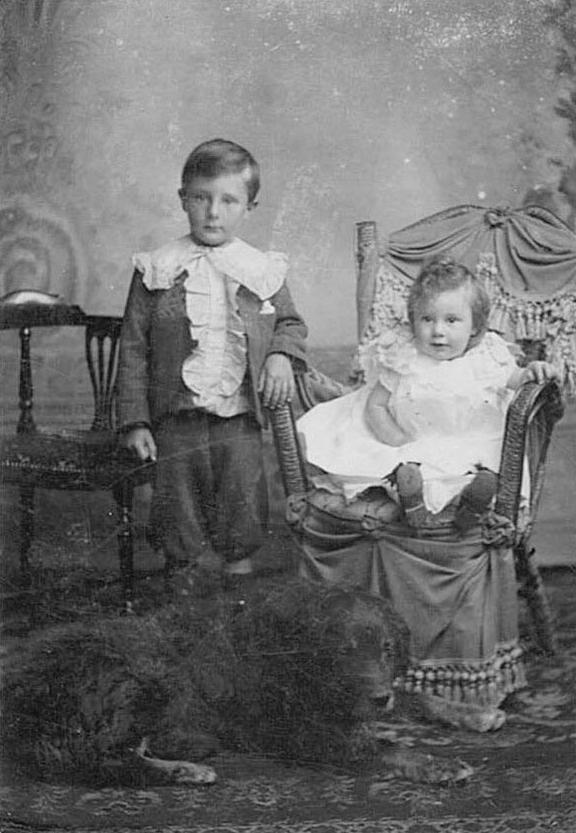
English Boys Blouses: Chronology -- 19th Century

Figure 1.-- Here we see unidentified boy with his baby sister in a cabinet card portrait. Je looks to be about 7 years old. The ruffled collar of his Fauntleroy blouse is so large that we can't tell much about his suit jacket. It includes knicker pants. The portait is undated, but was probably taken in the 1890s. The studio was E. Williams in Hawkhurst.
|
|
We have noted significant changes in blouses in the 19th century. We believe that the 18th centrury trens concerning the blouse persisted into the early-19th century. The blouse continued to be worn by workimg men, peasants, and lower-class women, After the Napoleonic Wars we see aristic men beginning to wear fancy blouses. Artistic women at the time were less common and as as far as we know did not wear blouses. Lord Byron was especailly famous for his fancy blouses worn with open necks. We do not know much about early-19th cetury bouses. Without photography fashion trends are difficult to follow. The English phtographic record is sparse at mid-century, much smaller than the case in America. This is unfortnate as weotice a lot of boys wearing shirts or blouses (1840s-50s). Suddenly photographic image become available in large numbers (1860s). The increase was exponential. We note small collars just barely peeping out from suit jackets in most studio portaits. The cut-away jacket might have exposed more of the shirt-like garment excepthey were connony worn with vests (1860s-70s). Thus it is often not clear just what the boys are wearing under their jackets. And almost all studio portaits showed boys wearing suit jackers. We see a range of collar styles, basically all we can sse of the blouse or shirt. in the mid-19th century. But they seem generally small and often hidden by the clothes. Men of any staus did not waer blouses. The most famous blouse of the 1860s was the Italian Garibaldi blouse, a style adopted from the Italian peasntry. We see somewhat larger collars (1870s) As detachable Eton collars became popular this was commonly a shirt-waist, not a blouse. The Eton collar was the most English of all collar styles. We see some younger boys weating fancy blouses (1870s). This appears to have been a fashion trend begun in France. Major changes occured with the elaborate Fauntleroy blouses (1880s). We begin to see another major develoment with the ladies. Throughout most of the 19th century, women saw the blouse as unfashionable. Many women might not even have a blouse in their wardrobe. It was seen as a garment for working people and very informal. This also changed at the end of the decade. The blouse began to emrge as part of the normal working women’s wear as middle-class women began to enter the work force. The basic dress code for women employed in an office was a plain skirt with a simple blouse. This was captured by the Gibson Girl in America, but the same trnd was work in England.
HBC

Navigate the Boys' Historical Clothing Web Site:
[Return to Main English blouse chronology page]
[Return to Main English blouse page]
[Return to Main English shirt-type garments type page]
[Return to Main English shirt page]
[Return to Main English garment page]
[Introduction]
[Activities]
[Biographies]
[Chronology]
[Clothing styles]
[Countries]
[Photography]
[Topics]
[Bibliographies]
[Contributions]
[FAQs]
[Glossaries]
[Images]
[Links]
[Registration]
[Tools]
[Boys' Clothing Home]
Created: 9:29 AM 5/10/2019
Last updated: 9:29 AM 5/10/2019



